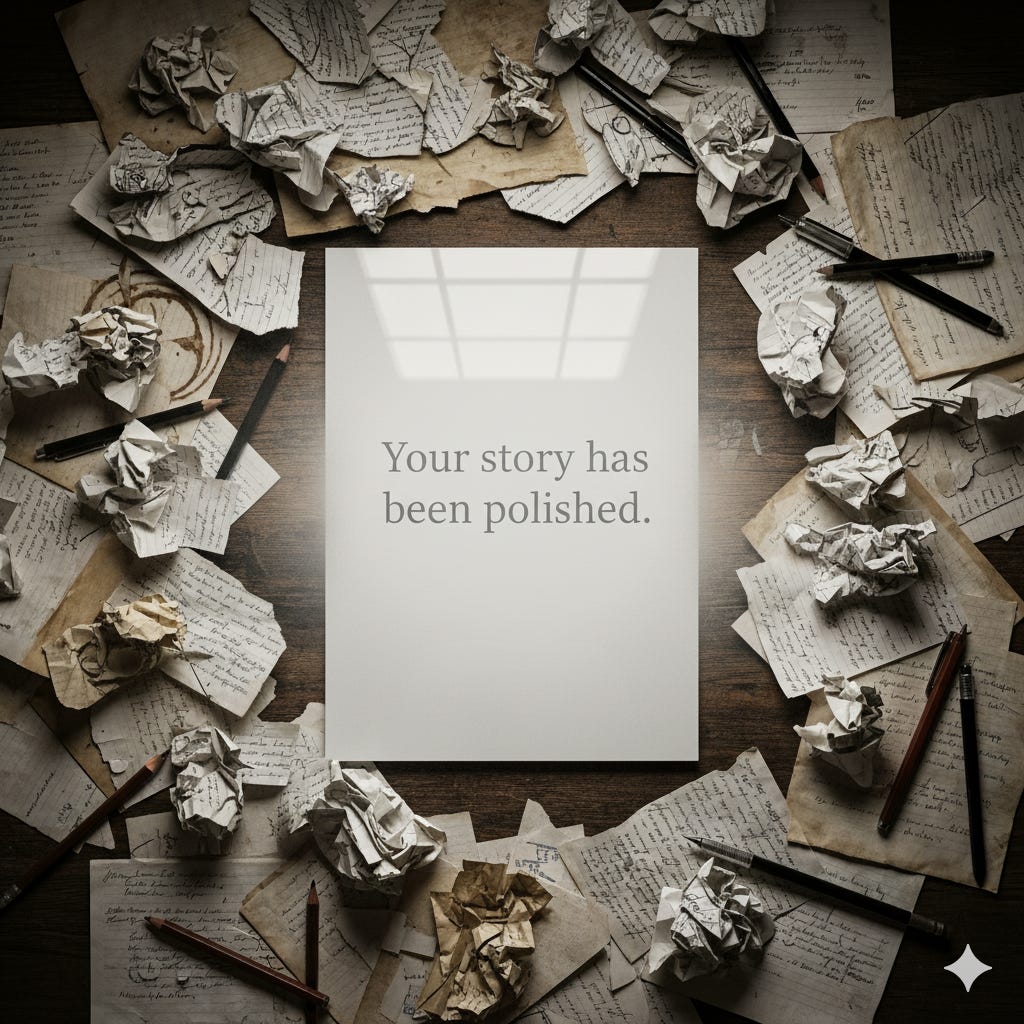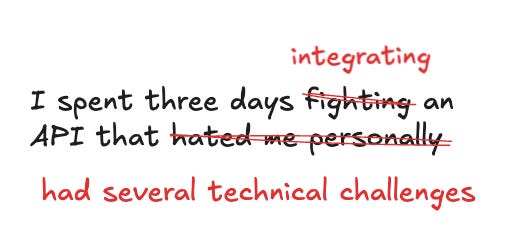For writers, tools like ChatGPT hold a special place in hell.
They’re just so damn effective. They make your writing glossy, synthetic, shiny. Impossible not to use.
But then you read someone else’s post, another LinkedIn update, a new Substack piece, and you can’t tell them apart.
They all use the same perfectly impactful prose and workshopped line lengths.
It’s so… over-produced. Frictionless. Perfectly optimized for a target audience of nobody.
And thats the irony: for something called Generative AI, it should help us generate something living! But somehow everything it touches takes on a plasticky sheen. Every sentence reads like an old-timey Transatlantic Hollywood narrator: polished, pleasant, and perfectly neutral. The kind of tone that erases the person behind it.
We tell ourselves we use these tools to write better, but really we want to sound more likable, more marketable, more perfect. The problem is that none of that makes us interesting. Chasing perfection leaves us with nothing.
I’d like to say I caught myself before falling into that trap. I didn’t.
In the back of my head I’ve always thought that there was a “better” version of my writing: a version with smoother prose and bigger, cleverer words.. But after working with ChatGPT I realize now that a lot of what I find interesting about my writing are these individualistic quirks. I tell too many stupid pop-culture jokes to be a serious technical publication. I mix philosophy and personal productivity with random Python code that no one will ever run. (If you ever meet me in real life I promise I do the same thing.)
When I hand my drafts to ChatGPT, it does what it does best: sands every edge down to a Substack appropriate sheen.
Only later did I realize the rough edges, the tangents, the jokes, the weird tone shifts, were me. The thing I was sanding down was my own fingerprint.
And this isn’t just a writing problem. It’s a human problem. Every time we smooth over our rough edges, in writing, in work, in interviews, we lose the very thing that makes us authentic. It’s the same impulse that makes us rewrite a Slack message five times so it sounds “friendly but professional.” We think we’re improving, but really we’re erasing the parts that allow people to relate with us.
The polish makes us easier to work with.
Nowhere did I feel this tension more than when prepping for behavioral interviews. We can argue about details, but at least the typical LeetCode and System Design interviews have a right or wrong answer, right? You shouldn’t write backend servers in JavaScript, no matter what flavor you use. There. I said it.
But behavioral interviews test a different, interpersonal skill set. They test how well you understand the constraints that you’re actually working under. The nitty gritty of the team itself, not just the work. Sure, everybody has a story about that one porcupine product manager, or the five alarm fire only we knew how to defuse. But in a stressful environment like an interview, it can be difficult to get all of the details out. Given the big help that ChatGPT gave me when prepping for LeetCode and System Design interviews, I was expecting similar results. And, just like the Genie from Aladdin, it delivered. Just not in the way I expected.
One by one, I shotgunned personal stories from an earlier dev team into ChatGPT. All the late night on-call issues, the heated discussions with other devs, the little wins that made me proud. (And would you believe that I can talk for a long time about software?) Then I asked it to help me reformat everything into the STAR method for storytelling in these interviews.
What came back for one of those stories was… perfect.
Four neat lines that could have described any software developer.
Two months of my life, the early morning meetings, the late night debugging sessions, the weekend migrations, all compressed into four short lines of text. It was the perfect behavioral answer: structured, safe, and completely lifeless.
All that passion and joy and stress and emotion had been polished until the grain vanished. ChatGPT left behind the structure of what happened but removed the why and how it felt. What remained felt more like sand-boarding over dunes than digging through archaeological ruins.
It was unsettling, not because ChatGPT had done anything wrong, but because it had done everything right. Like the Genie from Aladdin, it gave me exactly what I asked for: a perfect, structured version of my story. And that’s what unsettled me most, because it hadn’t misunderstood me; it had mirrored me. The AI was only doing what I already do: sanding down the tangents, the awkward moments, the messy truths that make the story real. We all do this. We all polish our stories until they shine, even if that means rubbing away the parts that prove we were really there.
The sanitized story doesn’t leave room for doubt in the original design, or for the help you got from another engineer at the last moment, the parts of the story that made it worth telling.
The same tool that polished my words too smooth also showed me what was hiding underneath the shine.
AI can help you write a better answer. But it can’t help you earn it.
Because the truth is, the moments that shaped you — the conflicts, the tension, the times you got it wrong — that’s the part that makes your story unique. The main character of the last blockbuster doesn’t become interesting because he beats the bad guy; he becomes interesting because he bleeds. The damage makes the difficulty meaningful.
ChatGPT can find the themes and polish the phrasing, but it can’t remember the hesitation before you admit something hard, or the weight in your stomach when the pager goes off. Those moments live in you, not in the text.
The older I get, the more I realize interviews aren’t about being impressive. Everyone’s built something hard, or worked on a team that did. What matters isn’t how polished the story sounds. It’s whether you can still recognize yourself in it.
Funny enough, it was ChatGPT, the thing that made my stories too smooth, that reminded me of that. It’s easy to think polish is progress, but sometimes the scuffs and scratches are the proof of life. The rough edges are the parts that remind you: you were there.
You earn those rough edges the way a craftsman earns scars: proof that you’ve shaped something real with your own hands.




